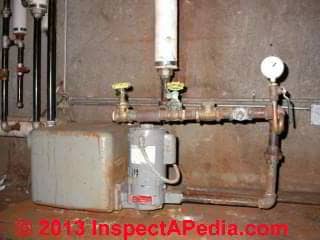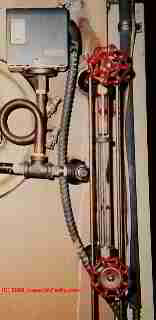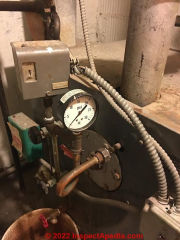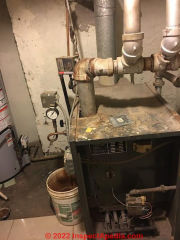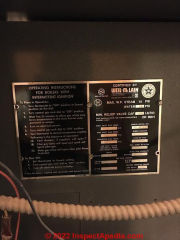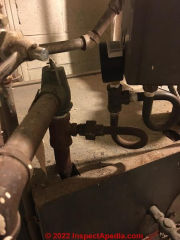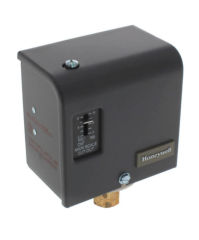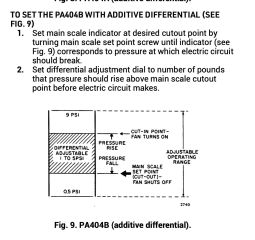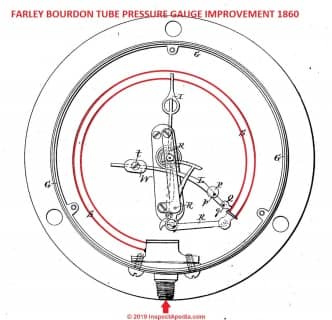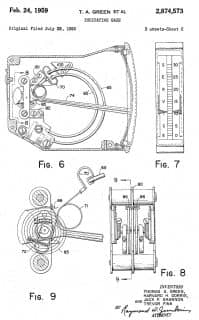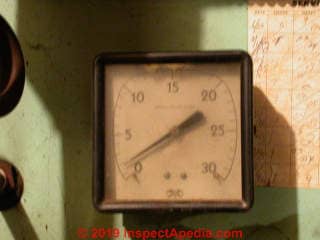 Steam Boiler Gauges
Steam Boiler Gauges
Guide to types, location, uses & how to read the pressure gauge on a steam boiler
- POST a QUESTION or COMMENT about gauges & gauge readings on low pressure residential type steam heating systems & boilers
Steam heating boiler gauges: this article describes the pressure or sometimes combination & temperature gauges found on most steam heating systems. The steam boiler gauge gives helpful pressure readings that tell us if the boiler is operating normally.
We also give a brief history of the Bourdon tube, a key pressure sensing and recording device invented by Eugene Bourdon, in France, and patented in 1852.
The steam boiler pressure readings at a boiler can help diagnose problems abnormally high pressure levels that often mean problems with the steam heat distribution system or its piping. We give normal low-pressure steam heating boiler pressure numbers and we explain what variations from these data signify.
InspectAPedia tolerates no conflicts of interest. We have no relationship with advertisers, products, or services discussed at this website.
Steam Boiler Pressure Gauge and Normal Pressure Ranges
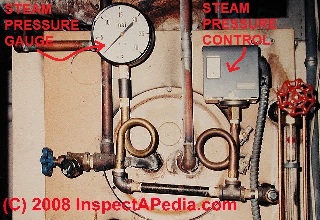
Pressure and Temperature gauge on steam heating boilers: Residential steam heating systems are almost always designed to operate at very low pressures, perhaps around .5 psi - that' s 1/2 of one psi.
You can see these pressures in our page top photo - both on the gauge and on the pressure controller.
You should see similar settings on the pressure gauge (at left in our photograph) and on the steam pressure control switch (the gray box at right in our photo) on your boiler.
The controls in this photo are discussed in detail
at STEAM HEATING SYSTEMS
and in detail STEAM PRESSURE CONTROL
and at STEAM PRESSURE GAUGE - this page
Article Contents
- STEAM BOILER NORMAL PRESSURE GAUGE READINGS
- STEAM BOILER GAUGE on CONDENSATE RECEIVER
- HOW A STEAM PRESURE GAUGE WORK: BOURDON TUBE
- HIGH PRESSURE on a RESIDENTIAL STEAM BOILER?
- WHEN TO ADD WATER TO THE STEAM BOILER
What Are the Normal Hot and Cold Operating Pressures of Residential Steam Heating Boilers?
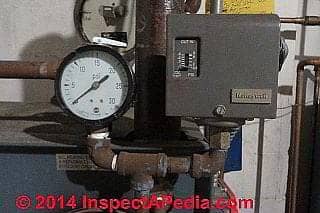 Residential steam heating systems are almost always designed to operate at very low pressures, perhaps around .5 psi - that' s 1/2 of one psi.
Residential steam heating systems are almost always designed to operate at very low pressures, perhaps around .5 psi - that' s 1/2 of one psi.
[Click to enlarge any image]
Take a look at our photo of a steam boiler pressure gauge shown here. If you enlarge the image you'll see that the steam pressure gauge on this Weil McLain Model 68 steam boiler reads about 0.5 psi - a setting consistent with the pressure set and shown on the scale on the steam pressure control to the right of the gauge.
If your residential steam boiler is operating at higher pressures than about 0.5 psi, that may be an indication that a service technician or owner was having trouble getting heat distributed through the building. Rather than finding and fixing the problem, someone is trying to "force" the steam around the system.
Take a look at the dial setting on your gauge or
see PRESSURE CONTROL, STEAM BOILERS
An experienced steam heat service technician will look at the operating pressure of your steam heating boiler and if it is not set to a normal level, the technician will look for the reason. Examples of problems that can affect the flow of steam heat through the system, leading to attempts to over pressurized the system include
- Blocked condensate returns at individual steam radiators
- Steam radiators tipped the wrong way
- Improperly relocated steam piping that has the incorrect slope
- Radiator valves that are not operating,
- Radiator steam vents that are not operating properly
See details at STEAM VENTS
For details about radiator problems see RADIATORS
and see LEAKS at BASEBOARD, CONVECTOR, RADIATOR.
Also see HEATING LOSS DIAGNOSIS-BOILERS.
More about steam boiler gauges is at STEAM PRESSURE GAUGE.
Steam Pressure Gauges on Condensate Receivers
At the right side of our photo of a remote building steam condensate receiver and pump system we see a steam pressure gauge that is used by the service technician to monitor pressure in the steam heating system.
This added information can be helpful when a central steam plant is feeding steam to multiple buildings.
In this case the photo shows a condensate receiver and pump in a Poughkeepsie New York building that is across a major street and several thousand feet from a central steam plant.
The steam gauge shown in the photo at left is installed with an isolating valve - that blue handle below the gauge itself. The handle is in the "open" position - allowing steam pressure to be read as you can see that the handle is parallel to the connecting piping.
Watch out: some technicians leave the isolating valve or handle for remote gauges in the closed position when the gauge is not in use. This is a "safe" position that protects from pressure, steam, or condensate loss should the gauge become damaged.
See CONDENSATE RETURN PIPES, PUMPS, STEAM for details about steam condensate return systems & controls.
Steam Boiler Sight Glass Gauge: When & How Much Water to Add to the Steam Boiler
If your steam boiler has an automatic water feeder you should see the water level always close to the fill-mark and the automatic water makeup valve will normally do this job for you.
When to add water to the steam boiler
If your steam boiler has only a manual valve for adding water, until you know the system's rate of water usage, you should check the water level at least once a week during the heating season.
You'll want to add water whenever the sight glass shows that the water level has dropped to the "add" mark and you should always see some water in the sight glass.
How much water to add to the steam boiler
The sight glass on a steam boiler, combined with a mark or gauge usually placed on the sight glass or on the boiler body behind the glass, will show the proper level to which the steam boiler should be re-filled when it's low on water.
See SIGHT GLASS, STEAM BOILER for details of this component.
Abnormally High Pressure in a Residential Steam Boiler?
As we said earlier, the usual operating pressure range for a residential steam boiler will be between 0.2 psi and 0.5 psi. You should see that setting on your pressure control and also on the steam boiler pressure gauge.
The discussion below describes a reader's steam boiler that appeared to be set to 8 psi - unusually high. Most-often when we see a residential boiler running at higher psi we suspect that there is a steam delivery problem somewhere in the building. Someone pushes up the steam pressure to try to "solve" lack of adequate heat.
Often a better repair is to find and fix a bad steam vent on one or more steam radiators or to find and fix improper steam pipe routing or condensate return pipe routing.
On 2022-04-14 by Wayne
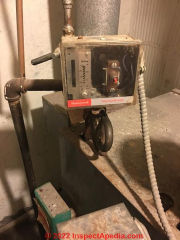 @Inspectapedia Com Moderator, Thank you. Very Appreciate your time, and sharing all this expertise with me.
@Inspectapedia Com Moderator, Thank you. Very Appreciate your time, and sharing all this expertise with me.
On 2022-04-13 by Moderator - residential Weil McLean steam boiler pressure gauge at 8 psi?
@Wayne,
I've never seen a residential steam boiler pressure control that came Factory preset 8 PSI. That would be way too high.
Steam Heat service technicians and installers certainly would be expected to know that.
When we see residential steam boiler pressure controls that are set to high pressures, it's often a sign of a desperate move to try to push heat to upper floors rather than find and fix the actual trouble in the steam piping itself or in the steam radiators or steam vents.
Years ago when we encountered this problem in a building the solution was to move the thermostat to the floor that previously wasn't getting enough heat.
On 2022-04-13 by Wayne
@Inspectapedia Com Moderator, Thank you. From your replies I think the stops and restarts of the burner might be the thermostat has reached the desired temperature so it stops and when it goes down it calls for heat again. The only thing is the temperature in the room where the thermal stat is situated changes quite quickly. That will explain the ghost control, the puzzle in my head.
P.s. Another issue is during the day the steam boiler runs and stops. Pipes in the basement and some of the first floor will get hot but the heat does not quite get up to the third floor.
My thermostat has 4 settings. Wake Leave Return and Sleep.
The Wake setting has no problem because there is a lot of time for the temperature to drop and this will make the burner run a long time to get to the desired temperature. The same for Returns.
The problem is the Leave. For example, you set the Leave from 10:00 am and the Return set to 6:00 pm. What happens is the burner will go on and off just to keep warm the basement or the first at maximum. Before for the heat to get to the third floor, the process is already off because the thermostat has already reached the desired temperature.
What are the options here?
On 2022-04-13 by Wayne
@Inspectapedia Com Moderator, This is the gauge I was talking about. I clean the pigtail. I changed the gauge with a new gauge. I don't see the gauge move.
My thought was: The Honeywell Cut In safety control is behind this gauge, if the gauge does not register pressure then that control is useless. I have to make sure this branch works as supposed to. I clean the track from the union to the inside of the boiler too but there was still no movement on the gauge.
I thought to add the new gauge to the relieve valve branch where the main pressuretrol is, and run for about 22 minutes this time and I still don't see any movement on neither gauges.
This photo shows where the new gauge is added
and this is the data tag
and this is a whole view.
I think I saw the new Resideo video from youtube by Mr. Gordon. He said this control comes pre-set from the factory to 8 psi for some reason and after the technician leaves is the owners time to bring down to 0.5 psi .
On 2022-04-11 by Inspectapedia Com Moderator
@Wayne
The pressure control is a safety device, not the main boiler operating control.
Shown below is a Honeywell (now Resideo_(Honeywell) A404A1025 Pressuretrol Controller w/ Subtractive: 1 psi to 5 psi Differential Pressure - the manufacturer and vendors describe its function as follows: (excerpt)
The PA404A is a pressure actuated high limit, safety control for steam heating boilers; it breaks an electrical circuit to shut down the burner if steam pressure rises above a safe level.
That's an example control - it may not match yours exactly.
See
RESIDEO (HONEYWELL) P404A,B STEAM HEAT HIGH LIMIT CONTROL MANUAL [PDF]
In the instructions you will see the illustration we give below - that is typical for a residential steam boiler.
Please see details about this control found at our Recommended Article listed above on this page:
PRESSURE CONTROL, STEAM BOILERS
Do post photos (one per comment) of your steam boiler gauge and of your steam boiler pressure control, as well as of the steam boiler itself and of its data tag, and we may be able to comment further.
On 2022-04-11 by Inspectapedia Com Moderator
@ Wayne ,
It's no surprise and not extremely worrying that the pressure gauge isn't responding or showing you that small pressure increase in your steam boiler when it runs.
The residential steam boiler operates at such low pressure that the most-accurate pressure gauge would be one operating in the 1-5 psi range. Other gauges showing a much higher pressure range, OR gauge whose pressure inlet is rust and debris clogged won't show a thing.
Most important for safety
- there must be a pressure relief valve installed on the boiler. If the relief valve is leaking water then the boiler pressure may be too high and the system unsafe.
- the steam boiler water supply must be maintained - check the water level in the sight glass; most boilers use an automatic water feed valve.
On 2022-04-11 by Wayne
@Inspectapedia Com Moderator, Thank you for your prompt reply. I have a Weil McLain Steam boiler. It runs but I don't see any movement from the glass pressure gauge.
I searched you tube and most of the suggestion is the pigtail being clogged. I cleaned it. Still does not move. I got a new gauge. Still does not move. To me it seams the boiler is only controlled by the thermalstat. The thermalstat call for heat the boiler starts. Once reaches the desired temperature, the thermalstat sends signal to shut it off. In between the burning process is on/off.
My question is: Which control is calling to stop and then start again since the Honeywell 404a is not doing the cut in and cut out.?
Reading this article makes me feel better. My take (the gauge did not move) is that the steam boilers are operating between 0.2 psi to 0.5 psi. but knowing this raise another question in my head, and that is: is the Honeywell 404a control installed there for in case there is abnormal conditions? meaning somehow, for some reason when the pressure goes higher?
On the other hand, I am still worried because I don't know for sure my boiler is operating withing those range. I don't know if all these safety controls are working properly in good condition. I know the low water cut off works, the Honeywell 404a if I push with my finger it will shut off the boiler so the electric circuit is there and will work if the pressure rises.
On 2022-04-11 by Inspectapedia Com Moderator
@Wayne,
I think I may not quite understand your question correctly. It seems to me that the operating pressure range of your boiler is going to be controlled 5 the pressure control that you described. So although it may be sucked higher than you would expect you would think your boilers pressure would be actually running between the cut in and cut out set on the control.
Are you saying that you were sure the pressure gauge wouldn't show any pressure change or is that your observation? And is it possible that your pressure gauge used to break log or that it simply just not one that registers in that small pressure range
On 2022-04-11 by Wayne
In normal operation, the pressure gauge will not move since the residential low steam boiler operates between 0.2 to half psi. The cut-in is set to 0.5 psi, and the differential is set at 1 psi. The boiler runs for 45 minutes. The honeywell 404a never trips. The thermal stat reaches 74 degrees and shuts off the boiler.
During this process now and then I do see the boiler stop and then start again. Since the honeywell control is not working. The question which control is making those stops and restarts? Should not I worry about the gauge is not give any indication when the boiler is on for so long?
On 2021-01-27 by danjoefriedman (mod) - my steam boiler gauge reads ZERO pressure: is that normal?
Anon
Normal residential steam boiler pressures will be very low, between about 0.2 and 0.5 psi.
On 2021-01-27 by Anonymous
i have a steam boiler and my gauge reads 0 is this normal for a low pressure system some of my radiators are dead cold
History & Mechanism of Bourdon Tube Pressure Gauges
On 2019-09-03 by (mod) - possible to open the gauge in order to place a small servo which could then be programmed to move the dial arm?
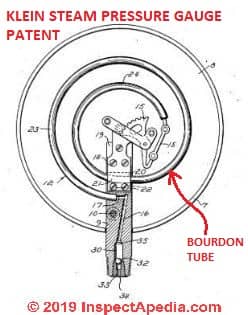 How interesting, Tim. We look forward to seeing your recreation.
How interesting, Tim. We look forward to seeing your recreation.
Typically a steam pressure gauge is operated by a type of bourdon tube that is wound into a spiral that responds to pressure and thence moves the needle pointer. I suspect you'll want to, in essence, gut the gauge, keeping just the needle and display. Then you can attach your servo to the needle axle.
You could experiment with trying to deform the tube with a servo but I'm not optimistic about that approach.
A representative illustration of the internals of a steam boiler pressure gauge using a bourdon tube is found in this patent by Maximilan Klein and assigned to US Gauge Company, - Maximilian, Klein. "Steam gauge." U.S. Patent 2,186,872, issued January 9, 1940.
You'll see that there is a small mechanism that converts movement of the Bourdon tube (patented in 1852) into a rotating mechanical movement to which you can attach a tiny servo.
The Klein patent from 1940 illustrates the ratchet and arm mechanism attached to the end of the Bourdon tube used to generate a movement in the steam pressure gauge corresponding to changes in steam pressure.
[Click to enlarge any image]
- Bourdon, Eugene, [BOURDON TUBE] PRESSURE GAGE [PATENT] [PDF] U.S. Patent No. 9,163, issued August 3, 1852, Eugene Bourdon, Paris France. Excerpt:
Be it known that I, the undersigned, Eugene Bourdon, of Paris, in the REpublic of France, engineer, a citizen of the REpublic of France, have invented a new and useful Improvements in Instruments for Measuring, Indicating, and Regulating the Pressure and Temperature of Fluids, of which the following is a full and exact description.
I have discovered that if a thin metallic tube be flattened and then bent or distorted from a straight line, it has the property of changing its form considerably when exposed to variations of internal or external pressure. An increase in internal pressure tends to bring the tube to a straight cylindrical form and the degree of pressure is indicated by the amount of alteration in the form of the tube.
Figure 1 represents a front view, Fig. 2 [excerpted and shown above] a back view and Fig. 3 a section of a pressure gage constructed on this principle and adapted for measuring and indicating the pressure of steam in steam boilers and for similar purposes. A is the flattened tube bent into a circular form and communicating by the cock B with a pipe (l connected to the steam boiler. The other end of the tube A is closed and is attached by a link D to the lever E fixed on a small spindle F which carries the index I.
The index moves over a graduated arc on the dial T.
The pressure of the steam causes the tube A to unfold itself a little and this motion being multiplied by the lever causes the index I to move a proportional distance on the graduated arc.
The arc is graduated by submitting the instrument to different pressures together with an ordinary mercurial pressure gage and marking the corresponding pressures on the dial. It will be found that for equal increments of pressure the degrees are equal or nearly so.
If the air be withdrawn from the interior of the tube A by means of an air pump or otherwise the curvature of the tube is increased and the index moves in the opposite direction and the instrument is then a vacuum gage.
If the air be withdrawn from the interior of the tube and it be then closed hermetically the curvature of the tube will vary with the pressure of the atmosphere and the instrument then serves as a barometer. Fig. 4 represents a front view of a barometer thus constructed. Fig. 5 is a back view and Fig. 6 a section of the same. A is the curved flattened tube fixed in the center at G and exhausted of air.
The two branches of the tube are connected by two links D D to two short levers on the axis F of the index I. By this arrangement the two branches of the tube balance each other and the instrument may be placed in various positions without affecting the position of the index. The links D D are connected to two small pins attached to a bent piece of metal H which may be sprung open by screwing down the conical headed screw K.
By this means the distance of the pins from the center of the axis may be adjusted and their leverage altered so as to adjust the index I to any required range. The index may also be shifted around on the axis and fixed by a small screw in any required position. The scale may thus be constructed independently of the rest of the instrument which is afterward adjusted to it by comparison with a good mercurial barometer.
Farley improved on Bourdon's design as explained in his patent dated just a few years later in 1860.
- Farley, Henry W., PRESSURE GAUGE [PDF], U.S. Patent No. 26,900 Issued 24 January 1860
Patent Excerpt:
Be it known that I, HENRY W. FARLEY, of Hannibal, in the county of Marion and State of Missouri, have invented an Improvement upon the Pressure-Gages Known as the Bourdon Gages, patented in France by one Eugene Bourdon, June 18, 1849, and in the United States by the same Eugene Bourdon, No. 9,163, August 3, 1852, and used for measuring, indicating, and regulating the pressure and temperature of fluids, and, among other things, for indicating the pressure of steam in locomotive and other engines; and I do hereby declare that the following is a full and exact description.
In the accompanying drawing, G, G, G, represents one form of the Bourdon gage, with the dial removed so as to present to view the active parts of the gage together with my improvement attached.
S, S, represents the curved tube or spring of the gage; R, R, R, the apparatus for communicating the motion of the tube or spring to the indicator I.
There is an imperfection in the action of the Bourdon gage caused by the vibration of the tube or spring S, when the gage is in motion by being carried upon a locomotive or otherwise, thereby producing a like vibration or unsteadiness in the indicator of the gage. The purpose of my invention is to remedy this imperfection.
Topic: Measuring the steady or quasi-steady pressure of a fluid or a fluent solid material by mechanical or fluid pressure-sensitive elements in the form of elastically-deformable gauges in the form of flexible, deformable tubes, e.g. Bourdon gauges
Ninety years later and of course informed by other inventors from the interim, Thomas A. Green et als improved on Farley's use of the bourdon tube and patented an indicating gage that converted changes in pressure to a vertical scale gauge rather than requiring a circular pressure indicator.
- Green, Thomas A., Harvard H. Gorrie, Jack F. Shannon, and Fink Trevor. INDICATING GAGE [PDF] U.S. Patent 2,874,573, issued February 24, 1959.
Patent excerpt:
Our invention relates to measuring instruments and United States Patent particularly to indicating pressure gages of the vertical edgewise class. The general shape is of a relatively thin rectangle with one end or edge of the rectangle fitted for visually observing the indication of-measurement by having one or more pointers arranged to move along a vertically located scale path;
Preferably the unit is mounted with the indicative scale substantially flush with:a panel board, the majority of the unit projecting behind the panel.
Our unitary construction is not, however, restricted to vertical edgewise panel mounting. One Widely accepted usage is for table mounting on bench or console type control panels where the scale edge of the unit is horizontal or at a slight inclination with the horizontal and with most of the unit projecting beneath the bench or console top.
Furthermore, the unitary enclosed construction allows the gauging-up or stacking of numerous units with the indicative scales parallel or end-to-end.
On the other hand, the unit maybe incorporated in an assembly of metering or control apparatus to advantage. While we have chosen to designate our invention as related to pressure gages, we so-name a general class without meaning to restrict the usefulness of the invention in the measurement of other variable quantities, qualities,
On 2019-09-03 by Tim - recreation of the Tower of Terror basement with boilers and a steam pressure gauge.
I am looking to do a recreation of the Tower of Terror basement with boilers and a steam pressure gauge.
I have found vintage steam pressure gauges and I am wondering if it would be possible to open the gauge in order to place a small servo which could then be programmed to move the dial arm.
Reader Comments, Questions & Answers About The Article Above
Below you will find questions and answers previously posted on this page at its page bottom reader comment box.
Reader Q&A - also see RECOMMENDED ARTICLES & FAQs
On 2018-09-21 by (mod) - What is the best price for a steam pressure gauge
Ankita
Steam boiler pressure gauges of the type used in low-pressure residential steam heating systems sell in the range of about
$18. to $35. USD.
But if you are asking at what "best price" WE can supply you with a pressure gauge, the answer is none whatsoever.
We don't sell anything,
InspectAPedia.com is an independent publisher of building, environmental, and forensic inspection, diagnosis, and repair information provided free to the public - we have no business nor financial connection with any manufacturer or service provider discussed at our website. We do not sell products nor services.
On 2018-09-21 by Ankita
What is the best price for this
On 2018-01-12 by (mod) - what is the usual pressure on a residential steam gauge vs medium pressure vs high pressure?
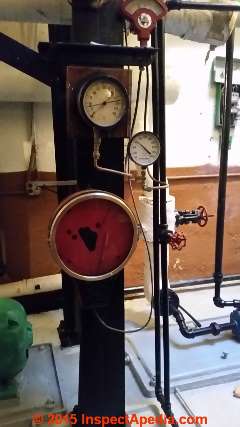 For residential low pressure steam systems
For residential low pressure steam systems
< 0.3 psi typical residential operating steam pressure
> 0.5 psi
in a residential steam boiler might a steam delivery problem being solved improperly by pushing steam pressure up
1 psi maximum residential operating steam pressure
Low pressure steam boilers are designed to withstand pressures UP TO 15 psi. At pressures above 15 psi the boiler would be unsafe.
High pressure steam boilers operate above 15 psi of steam pressure, and may be considerably higher. Inside a high pressure steam boiler water pressure may be 160 psig or higher.
In the article above on this page see the section titled
What are the normal hot and cold operating pressures of residential steam heating boilers?
See details at STEAM BOILER PRESSURE
For details about and examples of high pressure steam boiler operations see
STEAM BOILERS GENERATORS CONTROLS, PRATT
On 2018-01-12 by Santoshkumar .parmarsteam
steam pressure low presure medium . hypresure psi
On 2016-11-10 by (mod) what does negative boiler pressure in a steam boiler mean?
JH your boiler has cooled down AND there may be no water feeder working to add make-up water to the boiler so as it cooled it has formed a partial vacuum.
Watch out: DO NOT try to get this boiler to run before its water system has been repaired. Doing so would be unsafe.
On 2016-11-10 by JH
Just turned on the steam boiler last night. This morning the system is not running and the pressure gauge is reading - negative 10. What could be the issue here?
On 2014-11-25 by (mod) - debris or sediment may clog the boiler sight glass or drain
Faith
Commonly, as sediment settles in containers like boilers, the clog may be right at the drain valve.
Because of hot water and scalding hazards I'd prefer that you hired a trained service tech to clean the drain or if necessary replace the drain valve.
On 2014-11-25 by Faith
I skim the water from my steam boiler and I know the sight glass has gotten dirty but the water is not coming out fast. I think there is a clog in the system between the sight glass the the water drain gauge, how can I fix this or figure out where the clog is?
On 2014-04-09 by (mod) - when is a steam condensate pump needed?
AJ
We only need a condensate return pump in a steam system when there are heating locations that collect condensate that cannot return to the boiler by gravity. We never "circulate" condensate, and we don't normally need condensate pumps to return steam heat condensate from upper floors to a steam boiler located below.
On 2014-04-09 by a.j.
in a residential home with three floors of heating space. when or should you use a condensation circulation pump in system
On 2014-02-12 by (mod) - why don't some of my radiators get hot?
Alex,
In the ARTICLE INDEX we have several diagnostic articles under the topic of "Radiators" - those ought to help you out; we don't know from just your question if the problem is complicated or something simple like a closed radiator valve or bad steam radiator; another direction of investigation is a problem with condensate return from the radiators. Keep us posted;
Daniel
On 2014-02-11 by ALEX
my boiler is on but I do not get all the radiators get hot,they just get warm does not matter how long the boiler goes on.any idea. Please help me anyone >thank you
...
Continue reading at GAUGE REPLACEMENT, BOILER or select a topic from the closely-related articles below, or see the complete ARTICLE INDEX.
Or see these
Recommended Articles
- GAUGE REPLACEMENT, BOILER
- LOW WATER CUTOFF VALVE, BOILER
- PRESSURE CONTROL, STEAM BOILERS
- SIGHT GLASS, STEAM BOILER
- STEAM HEATING SYSTEMS & CONTROLS - home
- WATER FEEDER VALVE, STEAM
Suggested citation for this web page
GAUGES, STEAM BOILER at InspectApedia.com - online encyclopedia of building & environmental inspection, testing, diagnosis, repair, & problem prevention advice.
Or see this
INDEX to RELATED ARTICLES: ARTICLE INDEX to STEAM BOILERS
Or use the SEARCH BOX found below to Ask a Question or Search InspectApedia
Ask a Question or Search InspectApedia
Try the search box just below, or if you prefer, post a question or comment in the Comments box below and we will respond promptly.
Search the InspectApedia website
Note: appearance of your Comment below may be delayed: if your comment contains an image, photograph, web link, or text that looks to the software as if it might be a web link, your posting will appear after it has been approved by a moderator. Apologies for the delay.
Only one image can be added per comment but you can post as many comments, and therefore images, as you like.
You will not receive a notification when a response to your question has been posted.
Please bookmark this page to make it easy for you to check back for our response.
Our Comment Box is provided by Countable Web Productions countable.ca
Citations & References
In addition to any citations in the article above, a full list is available on request.
- [1] Power Technology and Engineering (formerly Hydrotechnical Construction), Volume 43, Number 4, 247-250, DOI: 10.1007/s10749-010-0105-4 - Thermal Power Stations, Temperature regime for damaged steam superheater coils, V. A. Bogachev (this is a PDF file - if you can't find contact SpringerLeak)
- [2] "Deaerator", Wikipedia, web search 12/18/11. Quoting:
The deaerators in the steam generating systems of most thermal power plants use low pressure steam obtained from an extraction point in their steam turbine system. However, the steam generators in many large industrial facilities such as petroleum refineries may use whatever low-pressure steam is available. - [3] Babcock & Wilcox Co. (2005). Steam: Its Generation and Use (41st ed.).
- [4] Thomas C. Elliott, Kao Chen, Robert Swanekamp (coauthors) (1997). Standard Handbook of Powerplant Engineering (2nd edition ed.). McGraw-Hill Professional. ISBN: 0-07-019435-1.
- Weil McLain Model 78 Boiler Manual, Boiler for gas, light oil, Gas/Light Oil fired Burners, Installation, Start-up, Parts, Maintenance instructions, Part No. 550-141-705/0600, Weil-McLain Administrative Office, 999 McClintock Drive, Suite 200, Burr Ridge, IL 60527
Tel: 855-248-1777
Consumer Inquiries: 800-368-2492
Technical Services: 800-526-6636 Technical Support for Contractors Only.
If you are a homeowner and are experiencing a problem with your Weil-McLain equipment, the first step you must take is to contact your installer or locate an HVAC contractor in your area. Website: http://www.weil-mclain.com - Bell & Gossett Air Separators and other heating system components, Bell & Gossett, 8200 N. Austin Ave., Morton Grove IL 60053, USA - Tel 847 966-3700 Fax 847 965-8379.
- Thanks to Bottini Fuel service manager Ron Thomas for discussing aquastat functions, low limit controls, oil burner short cycling causes, and boiler maintenance, reliability, and service contracts 4/13/2010. Bottini Fuel is a residential and commercial heating oil distributor and oil heat service company in Wappingers Falls, NY and with offices in other New York location
- Domestic and Commercial Oil Burners, Charles H. Burkhardt, McGraw Hill Book Company, New York 3rd Ed 1969.
- National Fuel Gas Code (Z223.1) $16.00 and National Fuel Gas Code Handbook (Z223.2) $47.00 American Gas Association (A.G.A.), 1515 Wilson Boulevard, Arlington, VA 22209 also available from National Fire Protection Association, Batterymarch Park, Quincy, MA 02269. Fundamentals of Gas Appliance Venting and Ventilation, 1985, American Gas Association Laboratories, Engineering Services Department. American Gas Association, 1515 Wilson Boulevard, Arlington, VA 22209. Catalog #XHO585. Reprinted 1989.
- The Steam Book, 1984, Training and Education Department, Fluid Handling Division, ITT [probably out of print, possibly available from several home inspection supply companies] Fuel Oil and Oil Heat Magazine, October 1990, offers an update,
- Principles of Steam Heating, $13.25 includes postage. Fuel oil & Oil Heat Magazine, 389 Passaic Ave., Fairfield, NJ 07004.
- The Lost Art of Steam Heating, Dan Holohan, 516-579-3046 FAX
- Principles of Steam Heating, Dan Holohan, technical editor of Fuel Oil and Oil Heat magazine, 389 Passaic Ave., Fairfield, NJ 07004 ($12.+1.25 postage/handling).
- "Residential Steam Heating Systems", Instructional Technologies Institute, Inc., 145 "D" Grassy Plain St., Bethel, CT 06801 800/227-1663 [home inspection training material] 1987
- "Residential Hydronic (circulating hot water) Heating Systems", Instructional Technologies Institute, Inc., 145 "D" Grassy Plain St., Bethel, CT 06801 800/227-1663 [home inspection training material] 1987
- "Warm Air Heating Systems". Instructional Technologies Institute, Inc., 145 "D" Grassy Plain St., Bethel, CT 06801 800/227-1663 [home inspection training material] 1987
- Heating, Ventilating, and Air Conditioning Volume I, Heating Fundamentals,
- Boilers, Boiler Conversions, James E. Brumbaugh, ISBN 0-672-23389-4 (v. 1) Volume II, Oil, Gas, and Coal Burners, Controls, Ducts, Piping, Valves, James E. Brumbaugh, ISBN 0-672-23390-7 (v. 2) Volume III, Radiant Heating, Water Heaters, Ventilation, Air Conditioning, Heat Pumps, Air Cleaners, James E. Brumbaugh, ISBN 0-672-23383-5 (v. 3) or ISBN 0-672-23380-0 (set) Special Sales Director, Macmillan Publishing Co., 866 Third Ave., New York, NY 10022. Macmillan Publishing Co., NY
- Installation Guide for Residential Hydronic Heating Systems
- Installation Guide #200, The Hydronics Institute, 35 Russo Place, Berkeley Heights, NJ 07922
- The ABC's of Retention Head Oil Burners, National Association of Oil Heat Service Managers, TM 115, National Old Timers' Association of the Energy Industry, PO Box 168, Mineola, NY 11501. (Excellent tips on spotting problems on oil-fired heating equipment. Booklet.)
- Our recommended books about building & mechanical systems design, inspection, problem diagnosis, and repair, and about indoor environment and IAQ testing, diagnosis, and cleanup are at the InspectAPedia Bookstore. Also see our Book Reviews - InspectAPedia.
- Domestic and Commercial Oil Burners, Charles H. Burkhardt, McGraw Hill Book Company, New York 3rd Ed 1969.
- National Fuel Gas Code (Z223.1) $16.00 and National Fuel Gas Code Handbook (Z223.2) $47.00 American Gas Association (A.G.A.), 1515 Wilson Boulevard, Arlington, VA 22209 also available from National Fire Protection Association, Batterymarch Park, Quincy, MA 02269. Fundamentals of Gas Appliance Venting and Ventilation, 1985, American Gas Association Laboratories, Engineering Services Department. American Gas Association, 1515 Wilson Boulevard, Arlington, VA 22209. Catalog #XHO585. Reprinted 1989.
- The Steam Book, 1984, Training and Education Department, Fluid Handling Division, ITT [probably out of print, possibly available from several home inspection supply companies] Fuel Oil and Oil Heat Magazine, October 1990, offers an update,
- Principles of Steam Heating, $13.25 includes postage. Fuel oil & Oil Heat Magazine, 389 Passaic Ave., Fairfield, NJ 07004.
- The Lost Art of Steam Heating, Dan Holohan, 516-579-3046 FAX
- Principles of Steam Heating, Dan Holohan, technical editor of Fuel Oil and Oil Heat magazine, 389 Passaic Ave., Fairfield, NJ 07004 ($12.+1.25 postage/handling).
- "Residential Steam Heating Systems", Instructional Technologies Institute, Inc., 145 "D" Grassy Plain St., Bethel, CT 06801 800/227-1663 [home inspection training material] 1987
- "Residential Hydronic (circulating hot water) Heating Systems", Instructional Technologies Institute, Inc., 145 "D" Grassy Plain St., Bethel, CT 06801 800/227-1663 [home inspection training material] 1987
- "Warm Air Heating Systems". Instructional Technologies Institute, Inc., 145 "D" Grassy Plain St., Bethel, CT 06801 800/227-1663 [home inspection training material] 1987
- Heating, Ventilating, and Air Conditioning Volume I, Heating Fundamentals,
- Boilers, Boiler Conversions, James E. Brumbaugh, ISBN 0-672-23389-4 (v. 1) Volume II, Oil, Gas, and Coal Burners, Controls, Ducts, Piping, Valves, James E. Brumbaugh, ISBN 0-672-23390-7 (v. 2) Volume III, Radiant Heating, Water Heaters, Ventilation, Air Conditioning, Heat Pumps, Air Cleaners, James E. Brumbaugh, ISBN 0-672-23383-5 (v. 3) or ISBN 0-672-23380-0 (set) Special Sales Director, Macmillan Publishing Co., 866 Third Ave., New York, NY 10022. Macmillan Publishing Co., NY
- Installation Guide for Residential Hydronic Heating Systems
- Installation Guide #200, The Hydronics Institute, 35 Russo Place, Berkeley Heights, NJ 07922
- The ABC's of Retention Head Oil Burners, National Association of Oil Heat Service Managers, TM 115, National Old Timers' Association of the Energy Industry, PO Box 168, Mineola, NY 11501. (Excellent tips on spotting problems on oil-fired heating equipment. Booklet.)
- In addition to citations & references found in this article, see the research citations given at the end of the related articles found at our suggested
CONTINUE READING or RECOMMENDED ARTICLES.
- Carson, Dunlop & Associates Ltd., 120 Carlton Street Suite 407, Toronto ON M5A 4K2. Tel: (416) 964-9415 1-800-268-7070 Email: info@carsondunlop.com. Alan Carson is a past president of ASHI, the American Society of Home Inspectors.
Thanks to Alan Carson and Bob Dunlop, for permission for InspectAPedia to use text excerpts from The HOME REFERENCE BOOK - the Encyclopedia of Homes and to use illustrations from The ILLUSTRATED HOME .
Carson Dunlop Associates provides extensive home inspection education and report writing material. In gratitude we provide links to tsome Carson Dunlop Associates products and services.


